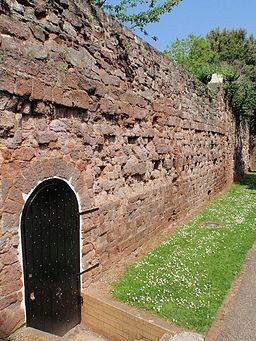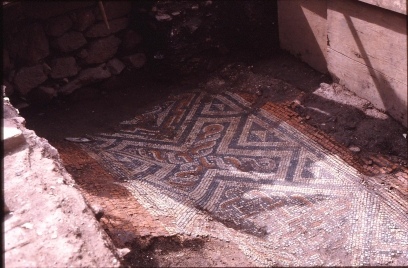
Exeter, England – It’s doubtful that readers will have heard much about this historically fascinating city – which is a great shame, as Exeter has much to offer. The city only has herself to blame for the discrepancy, however. This under-appreciated historical gem is blessed with an abundance of highly visible archaeological treasures – yet has a curiously blasé attitude to its history. Despite containing within its purview such marvels as the unique medieval Underground Passages, several miles of complete Roman wall, beautifully preserved Saxon fortifications, and the oldest public gardens in England (to name but the most obvious), Exeter has an incomparable talent for shooting herself in the archaeological foot.
Take her Roman baths, for example. For almost a thousand years these lay, forgotten, beneath a succession of churches nestled at the foot of the outstanding Gothic front of St Peter’s cathedral. The church builders of the past should not, perhaps, be held accountable for their burying of this absolutely unique outpost of Roman hygienic principles. Times and attitudes were very different, and besides, after the initial Saxon church was built over the site, the baths were soon forgotten. Nobody even knew that they were there – until the 1970s, when it was decided that the little church at the foot of the Cathedral was blocking the view of its (admittedly rather magnificent) West Front, and should accordingly be demolished to make way for something much more attractive (an underground parking lot). During the works, a Saxon burial ground was discovered – excavations of which quickly broke through to reveal a thoroughly unique and absolutely unexpected Roman bath house.
After a few weeks of excited discussion, the City of Exeter established that they had within their bounds a site of worldwide historical interest which could only advance the study of Roman provincial life and provide a massive tourism boost. They therefore did what seemed the only logical thing given these exceptional circumstances…and reburied the baths. Those with an interest in archaeology were obviously aghast at this decision, and have been campaigning for many years to bring back the diggers and once more expose the baths to the Devon sunlight. Now, some forty years after their re-internment, there may be a glimmer of hope upon the horizon for the Roman baths of Exeter. A recent statement by Exeter Cathedral indicates that they may be considering digging them up again in order to afford the site the investigation and public viewing it deserves.
Cutting-Edge Roman Technology
 To give the authorities their due, they buried the baths beneath grass and sand in order to make future re-excavation easier – and nobly refrained from smashing the whole thing to pieces for the sake of underground parking. This does at least indicate that they appreciated the significance of the find. Exeter was previously thought to be a very tenuous Roman holding; little more than a fortification at which a suffering legion would be placed in order to oversee the safe extraction and movement of tin from the wild moorlands of Devon and Cornwall. Surrounded on all sides by bleak, inhospitable country and uncivilized hill-tribes, it was thought that Exeter – or Isca Dumnoniorum as it was then known – was a somewhat utilitarian fortification. Despite the impressive walls built by the Romans (which still surround much of central Exeter today, see picture above right), it was generally thought that Roman interest in Exeter was fairly perfunctory, and that attempts at Romanization (as seen in less feral parts of the Empire) were not wasted upon Exeter and its environs. The discovery of the baths tells a different story. Archaeologists excavating the baths in the seventies discovered an impressive hypocaust – very cutting-edge for its time – which heated a large caldarium (hot room) dating from around 60-65 AD. Further excavation revealed a trepidarium (cold room), an expensive furnace house, an exercise yard, and multiple service rooms.
To give the authorities their due, they buried the baths beneath grass and sand in order to make future re-excavation easier – and nobly refrained from smashing the whole thing to pieces for the sake of underground parking. This does at least indicate that they appreciated the significance of the find. Exeter was previously thought to be a very tenuous Roman holding; little more than a fortification at which a suffering legion would be placed in order to oversee the safe extraction and movement of tin from the wild moorlands of Devon and Cornwall. Surrounded on all sides by bleak, inhospitable country and uncivilized hill-tribes, it was thought that Exeter – or Isca Dumnoniorum as it was then known – was a somewhat utilitarian fortification. Despite the impressive walls built by the Romans (which still surround much of central Exeter today, see picture above right), it was generally thought that Roman interest in Exeter was fairly perfunctory, and that attempts at Romanization (as seen in less feral parts of the Empire) were not wasted upon Exeter and its environs. The discovery of the baths tells a different story. Archaeologists excavating the baths in the seventies discovered an impressive hypocaust – very cutting-edge for its time – which heated a large caldarium (hot room) dating from around 60-65 AD. Further excavation revealed a trepidarium (cold room), an expensive furnace house, an exercise yard, and multiple service rooms.
_________________________________________________________________________________________
Above, an example of Roman mosaics found at Exeter.
__________________________________________________________________________________________
All in all, a well-developed bath complex – absolutely unique in Northern Europe – indicates an advanced Roman cultural element in what was previously thought a wild, Brythonic area into which only military Roman influence extended. For its time, the bath complex would have been quite superior. This demonstrates that someone found Exeter important enough to put considerable investment into, and that the population was Romanized enough to take full and profitable advantage of the facilities. Furthermore, this was one of the earliest stone-masonry buildings to be constructed in Roman Britain, which has huge implications for the status of Roman Exeter. This evidence is backed up by the discovery of a great many Roman mosaics, potsherds and so forth within the city – although the vast number of stern Roman fortifications in Devon and Cornwall does suggest that the hill tribes outside the city were neither particularly Romanized nor friendly.
Unacknowledged History
It is possible that the suppression of this evidence of Exeter’s importance to the Romans is due to confusion and disbelief. In Britain’s current London-centric culture, Exeter remains something of an isolated oddity. In a deeply rural part of Britain, often overlooked by central government, and somewhat sequestered between the wild moorlands of Dartmoor (famed as the fictional home of the Hound of the Baskervilles) and Exmoor (the home of the equally fictional and deadly Doones of Lorna Doone), Exeter is largely disregarded. This has allowed it to preserve much of its ancient character – Exeter Castle, for example, remained in civic use as the quarters of Exeter City Council until 2003 (when Health and Safety obligations forced the council into less ancient quarters), and Exeter’s 800-year-old Guildhall is widely thought to be the oldest non-religious building still used for its original purpose in Europe.
However, this adherence to historical veracity often comes at the expense of archaeological investigation. Institutions are used for their original purpose right up until the very last possible minute – and when that minute comes, their educational and tourism potential is often not appreciated. If used in conjunction with established educational resources, the wealth of archaeological history which is just lying around in Exeter could be of enormous research value – and bring a much needed tourism boost to the city. Unfortunately, however, Exeter has not yet learned to use its history in the manner that other, more up-to-date cities have. A case in point closely linked to the abandoned baths is Exeter’s Underground Passages. The Underground Passages date from the early medieval period, and became necessary when works on the Cathedral obstructed Exeter’s main water supply. The baths, situated on the site before the Cathedral was conceived, had utilized this abundant spring to full effect. However, the construction of the Cathedral cut off the water, necessitating the plumbing of clean water from alternate springs into the city. Then, as now, the pipes used to carry the water would need periodic repairs – yet rather than dig up the roads and obstruct traffic, the benevolent engineers of medieval Exeter elected instead to dig a series of underground passages to allow them easy access to the water pipes whenever needed. These ancient subterranean passages remain beneath the city, in good repair, and utterly unique – yet are relatively unknown. Although they are a visitor attraction and can be visited, they are little advertised, and visitors get an almost personal guided tour of the medieval underbelly of Exeter from enthusiasts delighted that somebody is finally taking an interest.
Looking Ahead
It is to be hoped that this display of interest in the Roman baths buried beneath the forecourt of Exeter Cathedral is not mere talk, and that efforts will be made to excavate this site and give it the status it deserves as one of the premier Roman areas of interest in the UK. It is also to be hoped that the renewed interest in Exeter’s archaeological history will prompt city authorities to make the most of their heritage, rather than leaving it to gradually dissolve, unpublicized and un-researched. Should this re-excavation prove successful, it could prompt the greatest outpouring of love for Exeter’s history since this marvelously eccentric city took up arms to defend a threatened Tudor building by placing it on iron wheels and rolling it up a hill. Certainly these early British baths could provide great insight into Romano-British culture, rendering this a story to be watched with deep interest and hope.
________________________
Cover Photo, Top Left: View of Exeter Cathedral. Markus Koljonen, Wikimedia Commons
______________________________________________________________________________________________________
Read about the most fascinating discoveries with a premium subscription to Popular Archaeology Magazine. Find out what Popular Archaeology Magazine is all about, including the special Holiday Discount offer. AND MORE:
 Popular Archaeology’s annual Discovery edition is a selection of the best stories published in Popular Archaeology Magazine in past issues, with an emphasis on some of the most significant, groundbreaking, or fascinating discoveries in the fields of archaeology and paleoanthropology and related fields. At least some of the articles have been updated or revised specifically for the Discovery edition. We can confidently say that there is no other single issue of an archaeology-related magazine, paper print or online, that contains as much major feature article content as this one. The latest issue, volume 2, has just been released. Go to the Discovery edition page for more information.
Popular Archaeology’s annual Discovery edition is a selection of the best stories published in Popular Archaeology Magazine in past issues, with an emphasis on some of the most significant, groundbreaking, or fascinating discoveries in the fields of archaeology and paleoanthropology and related fields. At least some of the articles have been updated or revised specifically for the Discovery edition. We can confidently say that there is no other single issue of an archaeology-related magazine, paper print or online, that contains as much major feature article content as this one. The latest issue, volume 2, has just been released. Go to the Discovery edition page for more information.
Subscription Price: A very affordable $5.75 for those who are not already premium subscribers of Popular Archaeology Magazine (It is FREE for premium subscribers to Popular Archaeology). Premium subscribers should email [email protected] and request the special coupon code. Or, for the e-Book version, it can be purchased for only $3.99 at Amazon.com.





